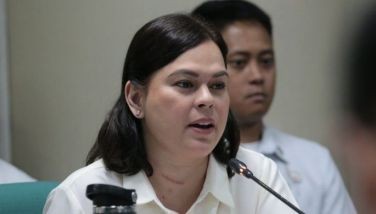Is Asean-China summit relevant to plain Pinoys?

October 31, 2006 | 12:00am
 NANNING, Guangxi Zhuang (via PLDT) – Touring in pleasant weather in the last three days such places as Xiamen, Jinjiang, Nanchang and Guilin in southeastern China, and seeing the uncluttered expressways and city streets, one wonders where the 1.3 billion mainland Chinese are.
NANNING, Guangxi Zhuang (via PLDT) – Touring in pleasant weather in the last three days such places as Xiamen, Jinjiang, Nanchang and Guilin in southeastern China, and seeing the uncluttered expressways and city streets, one wonders where the 1.3 billion mainland Chinese are.
One out of every five persons on earth lives in China, but this demographic fact may be altered in the next four decades. Despite improving health care and declining infant mortality, population growth is somewhat slowed down by Beijing’s one-child-per-family policy.
If trends continue, second most populous nation India (population: almost 1.2 billion) may yet overtake China by the middle of this century, what with its fertility rate of 2.8 compared to China’s 1.7.
What is the Filipina’s fertility rate? A galloping 3.1 percent! (Fertility rate refers to the number of children each woman would bear if she were to live to the end of her child-bearing years. Total fertility rate needed for a stable population is 2.1.)
With that huge market, we could double the pork barrel of lawmakers and the intelligence funds of the Executive departments, continue costly junkets, and tolerate commissions for capital expenditures and state contracts.
But I imagine that sugar was not among the talking points of President Gloria Arroyo when she had a one-on-one Monday morning with Chinese Premier Wen Jiabao before the opening of the ASEAN-China commemorative summit here.
The President, btw, co-chairs with the host prime minister the summit in this "green city" of Nanning, the capital of Guangxi Zhuang.
Talking to some of these enterprising Chinoys, I gather that when it comes to the Philippines, outward-looking mainland Chinese businessmen are more interested in trade than in investment.
This means that they are keener on buying and selling, on importing and exporting goods, than plunking sizeable capital in more or less permanent investments in the Philippines.
Government planners may want to study the reasons behind this apparent reluctance of foreign investors – not only those from mainland China – to risk their capital in the Philippines, and why they would rather go to other locations in the region.
In his remarks in Nanchang earlier, Meng Jianzhu, Communist Party secretary of the Jiangxi provincial committee and chairman of the Standing Committee of the Jiangxi Provincial People’s Congress, promised to encourage their businessmen to invest in the Philippines.
That was kind of him. Manila will wait for them. In the same program, President Arroyo herself also expressed the hope to see the investors when they come.
The more obvious concerns are: facing the North Korean nuclear threat, keeping the South China Sea lanes safe and open, resolving territorial claims, fighting terrorism (the US will always remind us about this their problem), and rationalizing globalization being pushed by the World Trade Organization.
To the teeming millions trying to survive in the kampongs and barangays in the Asean countryside, what would be the relevance of a top-level Asean-China get-together of their leaders?
A cynical Filipino reeling from hard times might ask: "Yan bang samit na yan ay nakakain? Magkano na naman bang ginastos diyan?" ("Can we eat that summit? How much are we spending again for that?)
These are the same questions that would likely be heard – and that must be answered – when the Philippines hosts in Cebu this December the 12th Asean Leaders’ Summit.
Btw, when I mentioned fears expressed elsewhere that time may be running out on the summit preparations, Cebu Gov. Gwendolyn Garcia, who is here, gave assurance that the venue will be ready.
Our foreign secretary who represented the Philippines in the Asean founding meeting in Bangkok was the late Narciso Ramos. He was the father of later-to-become-president Fidel V. Ramos, then a special forces colonel kibitzing in his father’s Padre Faura office on weekends.
The British protectorate of Brunei joined the Asean six days after that small but oil-rich sultanate became independent from Britain on Jan. 8, 1984. Its inclusion suddenly boosted the per-capita income of the Asean population.
The French-Indochinese states of Vietnam (in 1995), Laos and Myanmar (both in 1997) came in later. Cambodia followed suit in 1999.
Sitting with their giant neighbor in the North claiming 20 percent of the world’s 6.55-billion population, what can the Asean members representing 8 percent do?
A lot, if its leaders do not forget the efficacy of Asians’ patient consensus-building and their peoples’ innate neighborliness.
Having no access to the executive meeting is all right since the results will be announced later in the news anyway. There will be enough time to dissect them, if at all.
I said "if at all" because such meetings and their accompanying declarations usually end in diplomatic generalities. These are often not translated into action affecting in a profound and immediate way the lives of the population of the participating countries.
Anyway, that remains to be seen.
But I must mention that in the backup for my distance coverage of the summit, the Office of Presidential Protocol – especially the tireless and sleepless workers with Protocol Officer Menchie Dulay – was of great help.
My vote as the best tourist destination visited last Sunday by the Filipinos during their free time was Guiling, also in this autonomous province of Guangxi Zhuang. (It was granted autonomy to appease a minority in this southern part of China that is far from the capital.)
From Guiling, we took a four-hour cruise on two boats (one carrying the group with the President and another with her husband) on the spectacular Lijiang river unreeling like a velvet ribbon between limestone mountains rising majestically from bamboo groves along the banks.
Words, even photographs, cannot capture the splendor of this unbelievable video of nature at its exquisite best. You just have to see it!
For one, while the monument and Rizal’s figure on it look exactly (well, almost) as the original, they appear bigger. For another, the park where it stands seems rather extra-large for honoring a hero of a foreign country.
For still another, although Rizal may look familiar at first glance with his wavy hair and double-breasted coat, on closer examination I saw his figure to be a bit distorted. Others may disagree, but I think his head is small in proportion to his body and does not look (at least to me) like that one at the Luneta and on engravings.
We were told that Rizal’s great, great grandfather, one Domingo Lamco of Zhang-Guo province, was from that village.
The story goes that Chinese trader Cua Yi Lam immigrated from Siongque ("Zhang-Guo" in Mandarin) to the Philippines late in the 17th Century. Church records show that Cua Yi Lam was baptized Domingo Lamco in Manila in 1697 at the age of 35. He listed Siongque as his birthplace.
BrandSpace Articles
<
>
- Latest
- Trending
Trending
Latest
Trending
Latest
Recommended



























